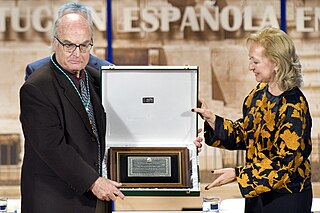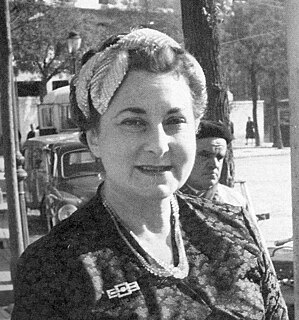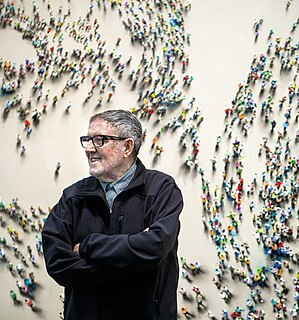



Baltasar Lobo (22 February 1910 - 4 September 1993) [1] was a Spanish artist, anarchist and sculptor [2] best known for his compositions depicting mother and child.




Baltasar Lobo (22 February 1910 - 4 September 1993) [1] was a Spanish artist, anarchist and sculptor [2] best known for his compositions depicting mother and child.
Born in Cerecinos de Campos, Zamora, Spain, he moved to Paris, France in 1939 where his sculpting would be influenced by Constantin Brâncuși and Jean Arp. Lobo's art was exhibited at the Galerie Vendôme on the Rue de la Paix along with notables such as Henri Matisse, Fernand Léger, Maurice Utrillo and Pablo Picasso.
Baltasar Lobo was one of the artists who contributed to the Ciudad Universitaria de Caracas project and did the illustrations for the English translation of Platero y Yo by Juan Ramón Jiménez. In 1984, he received Spain's National Award for Plastic Arts. [3]
Baltasar Lobo died in 1993 and was buried in Paris in the Cimetière du Montparnasse. The Museo Baltasar Lobo (museum) is in the city of Zamora, Spain near his birthplace.

Baltasar Gracián y Morales, S.J., better known as Baltasar Gracián, was a Spanish Jesuit and baroque prose writer and philosopher. He was born in Belmonte, near Calatayud (Aragon). His writings were lauded by Schopenhauer and Nietzsche.

Francisco Benjamín López Toledo was a Mexican Zapotec painter, sculptor, and graphic artist. In a career that spanned seven decades, Toledo produced thousands of works of art and became widely regarded as one of Mexico's most important contemporary artists. An activist as well as an artist, he promoted the artistic culture and heritage of Oaxaca state. Toledo was considered part of the Breakaway Generation of Mexican art.
José Caballero was a Spanish painter.

José Ramón Villa Soberón is a Cuban artist, particularly known for his public sculptures around Havana. He studied at the Escuela Nacional de Arte in Havana, Cuba and the Academy of Plastic Arts in Prague. He is a professor at the Instituto Superior de Arte in Havana. His sculptures, paintings, engravings, drawings and designs are held by the Museo Nacional de Bellas Artes de La Habana, and in 1996 he was one of the selected artist in the second Trienal Americana de Escultura in Argentina.
Manuel Cabré was a noted Spanish-Venezuelan landscape painter who is remembered as "the painter of El Ávila".
Saülo Mercader is a Spanish painter, sculptor and essayist. He was born on September 13, 1944, in San Vicente del Raspeig. He has lived in Paris since 1975.
Hugo Consuegra was a Cuban-American architect and artist specializing in graphic design, painting, and engraving.

Sebastián is a Mexican sculptor best known for his monumental works of steel and/or concrete in both Mexico and abroad. These include a number of “gate” sculptures such as the Gran Puerta a México in Matamoros, Tamaulipas but his most famous sculpture is the “Caballito” located in downtown Mexico City. His works are found in various countries outside Mexico, such as Japan where two are now used as city symbols.

Darío Antonio Suro García-Godoy was a Dominican painter, art critic, and diplomat from La Vega, Dominican Republic, remembered as one of the most influential Dominican artists from the 20th century. Suro's paintings encompassed a wide range of styles from the impressionist mood of his early paintings, to the neo-realism of his maturity, and finally to the abstraction of his later works. Together with his contemporaries Yoryi Morel, Jaime Colson, and Celeste Woss y Gil, he is known as one of the progenitors of modernist art in the Dominican Republic.
Eusebio Sempere Juan was a Spanish sculptor, painter and graphic artist whose abstract geometric works make him the most representative artist of the Kinetic art movement in Spain and one of Spain's foremost artists. His use of repetition of line and mastery of color to manipulate the way light plays on the surface give depth to his pictorial compositions.
Beatriz Zamora is a Mexican artist who is best known for her monochrome works in black. Although she has struggled commercially, her work has been recognized at various points in her career such as with membership in the Legion of Honor of the Académie des Beaux-Arts in France and the Sistema Nacional de Creadores de Arte in Mexico.

Ricardo J. Vicent Museros was a Spanish printer and publisher. After studying in Germany he returned to Valencia with new methods of work, advertising and graphic marketing. He founded the "Museo Nacional de la Imprenta y la Obra Gráfica" in El Puig de Santa María. He promoted the twinning of the cities of Valencia and Mainz (Germany). In 1992, the International Gutenberg Society granted him the "Gutenberg Prize" and in 2003 he received the "Cross of Civil Merit" from the German government for his work in favour of cultural relations between Spain and Germany.

Agustí Centelles Ossó was a Catalan photographer, working on the Republican side of the Spanish Civil War. As a refugee from Francoist Spain he was interned in France where he recorded life in the camp at Bram. He is considered one of the founders of Spanish photojournalism and has been called the "Spanish Robert Capa", with a "direct, spare style" and "great skill with the miniature Leica which enabled him to follow and photograph scenes of the Civil War."

Luis Gordillo is a Spanish artist and author. He is one of Spain's most prolific painters, and has received numerous awards including the National Award for Plastic Arts and the Premio Velázquez de las Artes Plásticas. Some of his work is exhibited at the Reina Sofia Museum in Spain.

Juana Mordó was born in Thessaloniki, Greece and was an art dealer and gallery director in Madrid, Spain.
Miguel Ángel Campano Mendaza was a Spanish painter who was critically acclaimed as part of the "generation of the renewal of Spanish painting", receiving, among other prizes, the National Award for Plastic Arts in 1996.
María del Carmen Laffón de la Escosura was a Spanish figurative painter and sculptor. She was a member of the Real Academia de Bellas Artes de San Fernando from 1998 until her death, and received numerous awards and honours, such as the Grand Cross of the Civil Order of Alfonso X, the Wise in 2017.
The National Award for Plastic Arts is one of Spain's National Culture Awards for Fine Arts, along with the National Award for Photography and Velázquez Award for Plastic Arts. Established in 1980, it is granted annually by the Ministry of Culture and Sport to recognize the meritorious work of contemporary plastic artists. It is given for works or actions published in the prior year which contribute to the enrichment of Spain's cultural heritage. Despite being developed by an administrative body, the selection of the award's winners is intended to be a true reflection of the values and feelings of society. It is endowed with a prize of 30,000 euros.

Juan Genovés Candel was a Spanish painter whose work is considered to symbolise the defence of democracy during the Spanish transition.